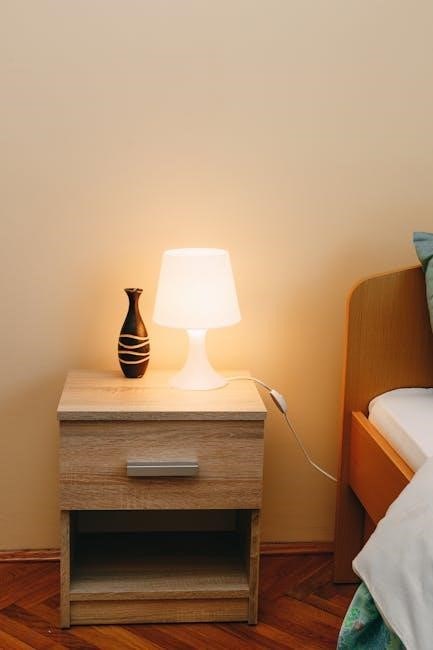Assembling your Ashley Furniture can be a rewarding experience, allowing you to personalize your space and enjoy the comfort of your new purchase. This guide provides a comprehensive walkthrough of the assembly process, ensuring a smooth and successful experience. By following these instructions, you can achieve professional-like results and enjoy your furniture for years to come.
Importance of Following Instructions
Following the assembly instructions for Ashley Furniture is crucial for ensuring safety, preventing damage, and achieving a successful outcome. Proper assembly prevents structural issues and ensures the furniture functions as intended. Ignoring instructions can lead to improper assembly, potentially causing product failure or injury. Always read the manual thoroughly before starting, verify all parts are included, and assemble on a non-abrasive surface to avoid damage. Adhering to these guidelines ensures a smooth process and long-lasting enjoyment of your furniture.
Overview of the Assembly Process
The assembly process for Ashley Furniture involves a series of organized steps designed to ensure a smooth and efficient experience. Begin by unpacking and organizing all parts, then follow the provided sequence to assemble components. Each step is detailed in the manual, often accompanied by illustrations to guide you. Key tasks include attaching legs, aligning frames, and securing panels. Proper assembly ensures stability and functionality. Always work on a non-abrasive surface to prevent damage and consult the manual if unclear. This systematic approach helps you achieve professional-like results.

Essential Tools and Materials Needed
Assembly requires basic tools like Allen wrenches, screwdrivers, and a rubber mallet. Ensure all parts and hardware are included. Use a non-abrasive surface to prevent damage.
Common Tools Required for Assembly
Essential tools include an Allen wrench, screwdriver, and rubber mallet. Optional tools like clamps or a power drill can speed up the process. Always ensure all parts are included and organized. A non-abrasive surface is recommended to prevent damage. Refer to the manual for specific tool requirements, as some pieces may need specialized hardware. Proper tools ensure a secure and efficient assembly, avoiding potential damage to the furniture. Organize your tools beforehand to streamline the process and minimize delays.
Additional Materials for a Smooth Process
To ensure a smooth assembly, gather materials like a non-abrasive surface, cardboard, or soft cloths to protect furniture from scratches. A marker or labeler can help organize parts. Optional materials include clamps for holding pieces in place and a power drill for faster screw driving. Ensure the workspace is clean and free from obstructions. Having these materials ready will streamline the process and prevent potential damage to your furniture. Proper preparation ensures a hassle-free assembly experience.

Understanding the Assembly Instructions
Read all instructions carefully before starting. Ensure all parts are present and understand the sequence. Detailed illustrations and expert guidance help clarify complex steps for a successful assembly.
Reading and Interpreting the Manual
Reading the manual thoroughly is crucial for a successful assembly. Start by reviewing all pages to understand the process and identify all components. Check for any specific tools or materials required. Pay attention to diagrams and illustrations, as they provide visual guidance for complex steps. Ensure you understand the assembly sequence and any safety precautions. If unclear, refer to online resources or contact support for clarification. Taking the time to interpret the manual correctly will help avoid mistakes and ensure a safe, efficient assembly process.
Identifying Parts and Components

Identifying parts and components is the first step in a successful assembly. Carefully unpack and organize all items, referencing the manual’s parts list. Match each piece to its description or diagram to ensure everything is accounted for. Labeling or grouping similar components can help streamline the process. Double-check for any damage or missing items before proceeding. If unsure about a part’s purpose, consult the manual or contact customer support for clarification. Proper identification ensures a smooth assembly experience.
Role of Illustrations and Diagrams
Illustrations and diagrams play a crucial role in simplifying the assembly process. They provide a visual guide, helping you understand how parts connect and fit together. Detailed diagrams clarify complex steps, reducing confusion and ensuring accuracy. By referencing these visuals, you can identify components and their proper placement. This makes the assembly more intuitive, especially for those less experienced with DIY projects. Always cross-check the manual’s illustrations with your parts to avoid mistakes and ensure a seamless assembly experience.
Preparing the Workspace
Choose a spacious, non-abrasive surface to assemble your furniture. Protect the floor and surroundings from damage. Ensure proper lighting for clear visibility during the assembly process.

Choosing the Right Location
Select a spacious, flat, and stable surface for assembly. Avoid carpets or uneven floors to prevent damage; Ensure the area is clear of obstacles and provides enough room to maneuver parts. Ideally, choose a location close to where the furniture will be placed to minimize moving heavy components. A non-abrasive surface, like a soft cloth or mat, can protect both the furniture and the floor during assembly. Proper lighting and accessibility to tools will also enhance the assembly experience.
Protecting the Floor and Surroundings
Before starting assembly, cover your work surface with a soft cloth, mat, or cardboard to prevent scratches and damage. Protect walls and nearby furniture with drop cloths or plastic covers. Ensure the area is clear of breakable items to avoid accidental damage. Use felt pads or rubber feet on heavy components to prevent floor scratches. Additionally, have cleaning supplies ready to address any spills or debris during the process. Taking these precautions will help safeguard your home and ensure a smooth assembly experience.
Ensuring Proper Lighting

Proper lighting is essential for a safe and accurate assembly process. Use bright overhead lighting or task lamps to illuminate your workspace. Ensure the light source is positioned to minimize shadows, allowing you to clearly see small parts and instructions. Avoid working in dimly lit areas, as this can lead to mistakes or accidents. Good lighting will help you read diagrams, identify components, and tighten connections effectively, ensuring a smooth and successful assembly experience.

Safety Precautions
Always wear protective gear, including gloves and safety glasses, to prevent injuries. Be aware of sharp edges and heavy components, and ensure proper handling to avoid accidents.
Wearing Protective Gear
Protective gear is essential to ensure safety during assembly. Always wear gloves to prevent cuts and abrasions, and use safety glasses to shield your eyes from debris. Proper footwear and clothing that allows freedom of movement are also recommended. Avoid loose jewelry that could get caught in parts. By prioritizing safety, you minimize the risk of injury and create a secure environment for assembling your furniture. This precautionary step is crucial for a hassle-free experience.
Avoiding Common Hazards
During assembly, avoid common hazards like sharp edges, heavy parts, and improper tool use. Ensure the workspace is clear of clutter to prevent tripping. Keep children and pets away to avoid distractions. Never overload screws or bolts, as this can cause structural weakness. Avoid using power tools near flammable materials. Properly align parts before tightening to prevent damage. By being mindful of these potential risks, you can ensure a safe and efficient assembly process for your Ashley Furniture.

Handling Heavy Parts Safely
When handling heavy parts during assembly, always lift with care to avoid injury. Use a second person for assistance or employ mechanical aids like dollies. Ensure the part is securely gripped and balanced before moving. Place heavy components on a stable, non-abrasive surface to prevent damage. Avoid sudden movements and maintain control throughout the process. Properly align parts before final placement to ensure stability. By prioritizing safety, you can protect both yourself and your furniture from potential harm.
Step-by-Step Assembly Guide
A comprehensive guide providing detailed, step-by-step instructions to ensure a smooth assembly process. Follow the sequence carefully to achieve professional-like results and enjoy your new furniture.
Unpacking and Organizing Parts
Begin by carefully unpacking all components from the boxes. Ensure all parts, hardware, and instructions are accounted for using the provided inventory list. Separate and label each item to avoid confusion. Place small components like screws and bolts in a safe container to prevent loss. Lay out larger parts in an organized manner, referencing the manual for clarity. This step ensures a systematic approach, reducing assembly time and potential errors. Always assemble on a non-abrasive surface to protect your furniture from damage.
Following the Assembly Sequence
Start by following the step-by-step instructions provided in the manual. Begin with the base or foundation of the furniture, ensuring all parts align correctly. Attach legs, frames, and supports as directed, using the hardware provided. Build upward systematically, verifying each component fits securely before moving on. Refer to the parts list to confirm all items are used in the correct order. Proper alignment and tightness are crucial for stability. If a step seems unclear, revisit the instructions or illustrations for clarification. Proceed methodically to ensure a sturdy and balanced final product.
Tightening and Securing Components
Once all parts are in place, use the provided tools to tighten screws, bolts, and other hardware. Ensure all connections are secure but avoid over-tightening, which may damage the material. Start with the base and work upward, tightening each component systematically. Double-check all joints and alignments for stability. Refer to the manual for specific torque requirements or recommended tightness levels. Properly securing each part ensures the furniture’s durability and functionality, preventing wobbling or structural weakness over time.

Troubleshooting Common Issues
Identify missing or damaged parts early to avoid delays. Check for proper alignment and tighten loose connections. Consult the manual for unclear steps or contact support for assistance.
Identifying Missing or Damaged Parts
Before starting assembly, thoroughly inspect all components for completeness and damage. Cross-reference the parts list in the manual to ensure nothing is missing. Check for dents, scratches, or broken pieces, as these can hinder assembly. If any parts are damaged or missing, contact customer support immediately to avoid delays. Proper identification early on ensures a smoother assembly process and prevents potential issues later. Addressing these concerns upfront saves time and frustration.
Resolving Alignment Problems
If parts do not align properly, double-check the manual to ensure correct placement. Verify that all components are properly identified and oriented. If misalignment persists, gently loosen any secured parts and reposition them according to the instructions. Avoid forcing pieces, as this may cause damage. Patience and careful rechecking of connections can resolve most alignment issues effectively, ensuring a sturdy and balanced final assembly.
Dealing with Unclear Instructions

If instructions are unclear, refer to the provided illustrations or online manuals for additional clarity. Contact RTA Parts at 1-844-966-0809 for assistance. Ensure all parts are correctly identified and aligned. If confusion persists, revisit the assembly sequence or consult the user manual. Detailed illustrations and expert guidance are available to help resolve unclear steps, ensuring a smooth assembly process. Don’t hesitate to seek support to avoid errors and achieve a successful outcome.
Maintenance and Care Tips
Regularly clean and dust your Ashley Furniture to maintain its appearance. Inspect and tighten connections periodically to ensure stability. Protect surfaces from spills and scratches for longevity.
Cleaning and Dusting Furniture
Regular cleaning and dusting are essential to maintain the appearance and longevity of your Ashley Furniture. Use a soft, dry cloth to wipe down surfaces, removing dust and debris. For more thorough cleaning, dampen the cloth with water, but avoid soaking the material. Avoid harsh chemicals or abrasive cleaners, as they may damage finishes. For upholstered pieces, gently vacuum or spot clean spills immediately with a mild detergent. Always follow the specific care instructions provided for your furniture’s material. Regular maintenance ensures your furniture remains pristine and durable for years to come.
Inspecting and Tightening Connections
Regularly inspect all connections and joints to ensure stability and durability. Check for loose screws, bolts, or fittings, and tighten them as needed using the appropriate tools, such as an Allen wrench or screwdriver. Refer to your assembly manual for specific torque recommendations. Avoid over-tightening, as this may damage the material. Inspect metal frames for signs of wear or rust and address any issues promptly. Periodic checks will help maintain the structural integrity of your furniture and prevent potential safety hazards. Consistent maintenance ensures long-lasting performance and reliability.
Protecting Surfaces from Damage
To maintain the appearance and longevity of your Ashley Furniture, protect surfaces from spills, scratches, and fading. Use coasters, pads, or placemats to prevent water marks and scratches from glasses or dishes. Avoid placing hot objects directly on surfaces; use trivets or heat-resistant mats instead. Regularly clean surfaces with a soft cloth and mild detergent to remove dust and stains. Avoid harsh chemicals or abrasive materials that may damage finishes. For upholstered pieces, consider using fabric protectors to repel stains and spills. Proper care ensures your furniture remains in excellent condition for years to come.
With careful attention to the instructions, your Ashley Furniture assembly is complete. Enjoy your newly assembled piece, knowing your effort has created a comfortable and stylish space.
Final Check and Inspection
Once assembly is complete, perform a final check to ensure all parts are securely fastened and properly aligned. Verify that all connections are tight and the furniture is stable. Double-check that no parts are missing or damaged. Inspect the surfaces for any scratches or dents. Refer back to the manual to confirm everything is assembled correctly. Ensure all safety precautions, like proper weight distribution, are met. This final inspection guarantees your furniture is safe, functional, and ready for use. Take pride in your accomplishment and enjoy your new piece!
Enjoying Your Newly Assembled Furniture
Congratulations! Your Ashley Furniture is now fully assembled and ready to enhance your living space. Place it in the desired location and add your personal touches, such as cushions, rugs, or decor. Regularly clean and maintain the surfaces to preserve their quality. Inspect connections periodically to ensure stability. Take pride in your accomplishment and enjoy the comfort, style, and functionality of your new furniture. Your effort has paid off, and it’s time to relax and appreciate the fruits of your labor!
